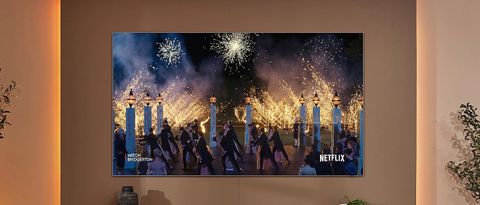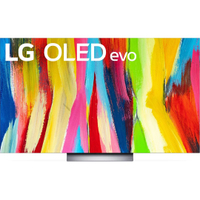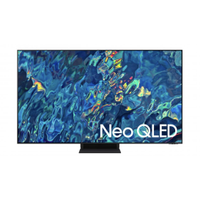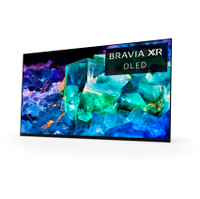TechRadar Verdict
The Samsung QNQ00B is an admirable TV in many ways, but this 8K set feels ultimately specified for tomorrow rather than for today – and by today’s standards it’s got some issues.
Pros
- +
Slim and elegant design, with One Connect box
- +
Bright, colorful and visually dynamic images
- +
Good gaming support
Cons
- -
Images can be over-processed or indistinct images
- -
No Dolby Vision HDR
- -
Inconsistent backlighting
Why you can trust TechRadar
Samsung QN800B: two-minute review
In some ways, the Samsung QN800B seems too good to be true. Here’s a TV from one of the biggest hitters around, with a complete suite of gaming features, a thorough smart TV experience, a better-specified audio system than you’d dare to expect, a external box to handle all physical inputs, a mini-LED screen that promises more effective backlighting than anyone is used to from LCD panels, and a profile slimmer than the slimmest OLED TV you can currently buy. Oh, and it’s got an 8K resolution for when the glorious day finally/hopefully arrives that native 8K content is commonplace.
So how come this isn’t a five-star review? Well, because ultimately it proves too good to be true.
Yes, there are unarguable positives to the way the Samsung QN800B performs. Brightness is considerable, black levels are impressive by the standards of backlit LCD screens, the color palette is extensive and naturalistic, and both edge-definition and motion control are impressive. With what little native 8K content is available, detail levels are staggering, at the level you'd expect from the best 8K TVs. It sounds wider and more expansive than you might be anticipating, too.
But the Samsung QN800B's backlight control isn't a match for the very best TVs, and the way the screen regulates its own brightness can make for some uneven viewing. Low-frequency sound is little more than a rumor. And because there are so very many pixels making up that 8K resolution, having to upscale anything less information-rich than 4K content can give the Samsung real problems.
And the QN800B’s case isn’t helped by the strength of its native 4K competition. No, neither the LG C2 or the Sony A95K are ready to wow you with 8K picture quality, but when it comes to displaying 4K content they’re both a better bet. And they don’t have (understandable, but no less irritating for it) palpitations when upscaling stuff of 1080p resolution or below, either. And that's before you get to Samsung’s ongoing refusal to engage with Dolby Vision HDR, which simply looks out of touch at this point.
We tested the 65-inch version of the Samsung QN800B for this review.
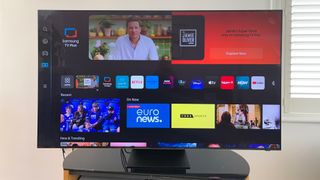
Samsung QN800B review: Price & release date
- Released in March 2022
- 65-inch version costs £2,699 / $2799 / AU$4499
- Also available in 75-inch and 85-inch models
The Samsung QN800B 8K MiniLED TV is on sale now, and the 65-inch version we’re testing costs $2,799 / £2,699 / AU$4,499 now – which is a fair amount less than it cost at launch. There’s also a 75-inch version that’s yours for $3,499 / £3,999 / AU$6,499, while the 85in variant will set you back $4,499 / £4,399 / AU$8,999.
High-performance 65-inch TVs from aren’t in short supply at this sort of money, of course – but none of the obvious price-comparable alternatives are 8K models. So for the early adopters among us, those who are confident the 8K resolution is going to be the Next Big Thing in television technology, the 65QN800B looks a pretty compelling proposition.
Samsung QN800B review: Features
- 8K resolution and mini-LED backlight
- No Dolby Vision HDR support
- Great HDMI 2.1 connectivity in One Connect box
The headline feature here, naturally, is the panel’s native resolution. A pixel-count of 7680 x 4320 means a total of 33,177,600 pixels – a number, of course, that dwarfs the 8,294,400 pixels that make up a 4K display. The potential for superior picture quality from an 8K screen, where sharpness and detail and basic fidelity are concerned, is obvious.
Of course, this does rather depend on their being some native 8K content available to watch – and at the moment, ‘thin on the ground’ is to massively overstate its availability. Samsung is unfazed, as you might expect – it believes the QN800B’s upscaling ability means the 4K content you’re far more likely to feed it will look better (sharper and more detailed) than it would on a 4K screen.
The QN800B is a VA LCD screen, and uses mini-LED for backlighting. This means that it uses far more LEDs of far smaller dimensions than is common to backlight the LCD panel. This should, in theory, allow for more precise focus and control of the backlighting, making for better contrast. VA panels have a bad rep for off-axis picture fidelity, but Samsung has deployed its Ultra Viewing Angle Anti-Reflective technology in an effort to both mitigate the off-axis viewing issues and reduce the reflectivity of the screen.
You get four HDMI 2.1 sockets (one with eARC capability) plus three USB inputs, Ethernet and a digital audio output. Wi-Fi and Bluetooth 5.2 are available for wireless connections. And as with quite a few upper-tier Samsung TVs, all connectivity is kept off-board in a One Connect box, which connects to panel with a single cable. This can hug the rear of the stand if you’re using the QN800B on a surface, or it can stashed well out of the way if it’s to be wall-mounted.
The advantages of this approach are obvious: all physical connections bar one are kept away from the chassis of the screen, which makes for a far tidier look. Samsung provides two lengths of cable to join the One Connect box to the screen, for even greater convenience.
Because this is a Samsung television, and because Samsung is nothing if not bloody-minded, there’s no support for Dolby Vision HDR here. As usual with Samsung TVs, HLG, HDR10 and Adaptive HDR10+ dynamic metadata standards are catered for – and no amount of bleating on my part or righteous indignation on yours seems able to change the company’s mind, so far. The lack of Dolby Vision compatibility is an omission that’s worth bearing in mind, particularly if like to watch Netflix and Disney+, both of which support this format. Filmmaker Mode is included for purist movie buffs.
Samsung is perfectly happy to get on board with Dolby Atmos audio, though. The QN800B has a 4.2.2 speaker arrangement (some of which is visible on the rear of the screen) powered by a total of 70 watts and, in addition to a layout that’s intended to offer a taste of the height and width a Dolby Atmos soundtrack offers, it features Samsung’s Object Tracking Sound+.
This attempts to steer sound output in response to on-screen motion, and has proved moderately successful in our experience. And in addition, the QN800B is compatible with Samsung’s ‘Q Symphony’ technology that allows the screen’s audio system to join in with an appropriate Samsung soundbar, rather than be overridden by it. It also supports wireless Dolby Atmos connectivity with compatible 2022 Samsung soundbars, such as the Samsung HW-Q990B or Samsung HW-Q930B.
- Features score: 4.5/5

Samsung QN800B review: Picture quality
- 8K footage is incredible
- Colors are beautiful (on the right setting)
- Backlighting is strong, but not perfect
Samsung has been sensible enough to include the YouTube app on its smart TV homepage, and from there it’s possible to access some native 8K content. Admittedly it consists entirely of extended drone shots of landscapes, or images of plants or animals, but nevertheless one should never dismiss the opportunity to view 8K content on an 8K screen. Who knows when the opportunity will come again?
And it’s safe to say that while the content itself is tedious in the extreme, it looks – how best to put this? – utterly stupendous on the QN800B. Color fidelity is remarkable, detail levels almost laughably high, depth of field is outstanding… it seems very unlikely indeed that anyone could watch the QN800B delivering some expensively generated 8K content and not be impressed.
Back in the real world, however, things are less cut and dried. After all, the QN800B is going to spend the overwhelming bulk of its time upscaling 4K content (at best) – and so that’s really how we should judge it. And it’s safe to say that while the Samsung is seldom less than enjoyable to watch, it’s not what you’d describe as ‘flawless’.
On the ‘plus’ side, the QN800B does decent work with both black and white tones. The dark stuff is properly dark, with plenty of detail and variation within it, and the Samsung resists crushing black scenes into uniformity with real resolve. At the opposite end of the scale, white tones are bright (searingly so when the screen is first taken from its packaging and switched on), generally clean and similarly detailed. Contrasts, as a consequence, are wide and dynamic.
It’s worth noting the QN800B reins in its remarkable brightness when small white details appear in mostly dark scenes, though. Presumably this is in an effort to prevent any blooming or haloing from the backlighting, but it does have a rather disconcerting effect on your viewing experience. In all other circumstances, though, the Samsung’s mini-LED backlighting proves reasonably adept, although brightness is not exactly consistent: the center of the screen is noticeably darker than the corners.
The color palette is wide-ranging and, once you’ve made some necessary changes in the set-up menus, naturalistic – the screen’s default settings overdrive the primaries more than a little.
Edge definition is strong and smooth, and motion control is good in all but the most testing circumstances. Annoyingly, though, the most effective motion control comes from switching on ‘LED Clear Motion’ in the set-up menus, and this introduces a touch of the dreaded ‘soap opera’ effect.
The Samsung proves a capable upscaler of 4K content (and let’s not forget it’s basically inventing three-quarters of the on-screen information on the fly), although it can look a little edgy and over-processed when the going gets complex, even with ‘LED Clear Motion’ left well alone.
Of course, availability of 4K content is by no means a given, especially when watching broadcast TV – and there are, naturally enough, limits to what the QN800B’s Neo Quantum Processor 8K is capable of. Anything in SD, or from a less-detailed and older recording, is going to be soft. Ask yourself how often you’re going to be watching sub-1080p stuff before you commit to QN800B ownership.
- Picture quality score: 4/5
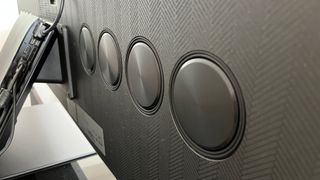
Samsung QN800B review: Sound quality
- Adds width and height to movies
- Good for detail and clear dialogue
- Doesn't really have any real bass to offer
You can’t criticize the lengths Samsung has gone to with the QN800B’s audio system, and in practice it proves a lot more listenable and convincing than is the norm for TVs without an external system. There’s genuine width to its presentation, and the tiniest suggestion of height to Dolby Atmos soundtracks too. The OTS+ technology has a discernible effect too – and when you add it all together you get a TV that sounds better than you might be anticipating.
The mid-range, in particular, is open and distinct, with a nicely naturalistic tonal balance and a fair amount of fine detail in evidence. The top of the frequency range remains nicely poised, too, unless you decide to really go for it, volume-wise. It’s only the bottom of the frequency range – which is predictably short of presence and gets easily flustered by big dynamic events – that really gives the game away.
Having said all this, though, you shouldn’t really be spending this sort of money on a television unless you’ve budget for (at the very least) one of the best soundbars to bring your audio experience into closer alignment to the visual. Samsung builds some very capable soundbars, and if you treat yourself to one that’s ‘Q Symphony’-enabled, the QN800B’s audio system can continue to contribute to the overall speaker arrangement in addition to the soundbar's speakers.
- Sound quality score: 4/5

Samsung QN800B review: Design
- Just 17mm at its thickest
- One Connect box makes it very tidy to look at
- Incredibly thin bezels
Given that it’s a mere 17mm deep, the QN800B is a prime candidate for wall-hanging. This is a consistent depth, too – none of your OLED-style ‘slim until it’s fat’ profile here. And when seen in profile, there’s quite pleasant perforation to the screen’s sides – this allows for dispersal of the heat generated by all those mini-LEDs, and for dispersal of sound too. From the dead-ahead, the Samsung is pretty much all screen – its bezels are brief in the extreme.
If you decide against wall-hanging (and given the 65-inch QN800B tips the scale at 23kg / 50 lbs , you may decide to err on the side of caution), it can stand on a sturdy, heavy (8kg / 18 lbs) central pedestal. Which is useful if for no other reason than the Samsung doesn’t need all that wide a surface to stand on. And, of course, no matter how you decide it’s to be positioned, the QN800B’s One Connect box means it’ll look neat and tidy when it’s there.
As is standard lately, the QN800B is supplied with a pair of remote controls. One’s a slim, solar-powered device covering the headline functions, while the other's a slightly chunkier, slightly more plasticky alternative with altogether too many buttons. The slimmer, nicer-to-hold handset features a ‘mic’ button – the Samsung is compatible with Alexa and Google Assistant voice control (and Bixby too, if you’re a Samsung employee).
It’s also possible to control the QN800B using Samsung’s ‘SmartThings’ app. It’s clean, tidy, stable and eminently usable, and allows the TV to integrate into your wider ‘SmartThings’ ecosystem if you so desire.
As far as build quality goes, there’s nothing overtly wrong with the way the QN800B is constructed, as you’d expect from a Samsung product. Some of the plastics used in construction, especially for the rear panel, don’t feel anything special, and there’s a disconcerting amount of flex in the frame when you first unbox and position it. But once it’s in place, of course, that ceases to be an issue.
- Design score: 4/5

Samsung QN800B review: Smart TV and menus
- Tizen software is full of streaming apps
- Interface is a bit much, though
- Easy to set up, or to get deeper into the settings
Both the smart TV interface and the operating system here come in the form of Tizen, as has long been Samsung’s wont. Lately, Tizen has taken a turn for the over-confident, covering the entire screen and with a ‘reworked’ menu structure that’s some distance from being intuitive.
The recommendations it makes can take a good while to catch up with your actual preferences, too. It’s packed with streaming services, though – and ‘Samsung TV Plus’, a free selection of quite esoteric programming, is actually quite welcome.
As far as set-up menus go, Samsung has hit a nice sweet-spot between ‘extensive’ and ‘usable’. If you want to put the hard yards in tweaking around the edges of performance in a search for picture performance that’s just so, that’s available to you.
If you want to take the QN800B from its box and hit on a workable picture balance inside five minutes, that’s available too.
- Smart TV & menus score: 3.5/5
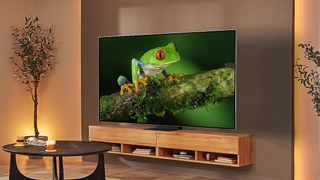
Samsung QN800B review: Gaming
All four HDMI inputs are HDMI 2.1 with full 48Gbps speed, featuring support for 4K 120Hz, ALLM, VRR and AMD FreeSync Pro. Add in an input lag time of less than 10ms (4K 60Hz) when in ‘Game’ mode and it’s obvious the next-gen console user is well catered for here.
Samsung’s ‘Game Bar’ feature is available too, so if you fancy pop-up information regarding frame-rate, refresh-rate and what-have-you, that’s all available at your fingertips.
‘Game’ mode keeps latency down to a bare minimum, but it does also allow brightness and color balance to become rather overconfident and even slightly coarse. The overall effect of the screen giving you everything it’s got whenever you switch your console on is not unlike being shouted at, and over time it’s rather draining.
But you need to balance this, as well as the accompanying increase in backlighting blooming, against the TV’s razor-sharp response times – more nuanced processing means more lag.
- Gaming score: 4/5
Samsung QN800B review: Value
The Samsung QN800B is a relatively affordable TV by 8K standards – but it doesn’t automatically follow that it represents great value. Sure, you’ve future-proofed yourself (if your reading of the runes leads you to believe 8K is going to become ‘a thing’ at some point) – but if you’re after a TV that looks great with 4K content then you’re not exactly short of choice.
Yes, the QN800B has four full-fat HDMI 2.1 inputs. It’s got a thorough and periodically intuitive smart TV interface. It’s a slim and good-looking object that’s ideal for wall-hanging, especially as it only needs one physical connection to deal with every eventuality. It’s got a solar-powered remote control, and who’s going to object to that?
However, the exemplary LG C2 is yours at 65 inches for under £2,000 / $2,000 these days, though, and it’s mighty difficult to argue against. Or if you just want to go with the best 65-inch 4K TV currently available and hang the expense, the Sony XR-65A95K is utterly incredible. And both of these alternatives have Dolby Vision HDR, too.
However, being OLED, neither reaches as bright as this Samsung, so if you watch a lot in bright rooms, the Samsung's image can cut through better… but that's also true of the 4K Samsung QN95B, which is much cheaper, and earned the full five stars from us.
- Value score: 3.5/5
Should you buy the Samsung QN800B?
| Attributes | Notes | Rating |
|---|---|---|
| Features | Extremely high-end specs overall, except the lack of Dolby Vision HDR. | 4.5/5 |
| Picture quality | Astounding with 8K, very good with 4K, but not perfect. | 4/5 |
| Sound quality | Good sense of space as positioning, but weak on bass. | 4/5 |
| Design | Gorgeously thin, with a useful One Connect box. A little plasticky in places. | 4/5 |
| Smart TV and menus | Tizen is comprehensive, but not the most intuitive smart platform. | 3.5/5 |
| Gaming | Great HDMI 2.1 support, though image quality is noticeably affected in Game mode. | 4/5 |
| Value | Good for an 8K TV, but you can get a better 4K model for less. | 3.5/5 |
Buy it if…
You want a more affordable 8K option
33m pixels have rarely been so affordable – it's much more affordable than the QN900B flagship 8K from Samsung, the LG Z2, or the Sony Z9K.
You're a gamer
HDMI 2.1 across the board + very low input lag = a pleasing next-gen console experience.
Don't buy it if…
You want to know what the HDR fuss is all about
Dolby Vision is the HDR dynamic metadata format of choice – except for Samsung TVs.
You'll watch a lot of lower-res stuff
The QN800B is a good upscaler, but not a miracle worker – it's too much to ask to upscale from SD to 8K.
Also consider
<a href="https://www.techradar.com/reviews/lg-c2-oled-oled65c2" data-link-merchant="techradar.com"">LG C2
Routinely available for less than $2,000 / £2,000 at 65 inches, and consequently prodigious value for money. Great image quality, strong brightness by OLED standards, a great gaming experience, and Dolby Vision HDR.
Simon Lucas is a senior editorial professional with deep experience of print/digital publishing and the consumer electronics landscape. Based in Brighton, Simon worked at TechRadar's sister site What HiFi? for a number of years, as both a features editor and a digital editor, before embarking on a career in freelance consultancy, content creation, and journalism for some of the biggest brands and publications in the world.
With enormous expertise in all things home entertainment, Simon reviews everything from turntables to soundbars for TechRadar, and also likes to dip his toes into longform features and buying guides. His bylines include GQ, The Guardian, Hi-Fi+, Metro, The Observer, Pocket Lint, Shortlist, Stuff T3, Tom's Guide, Trusted Reviews, and more.
